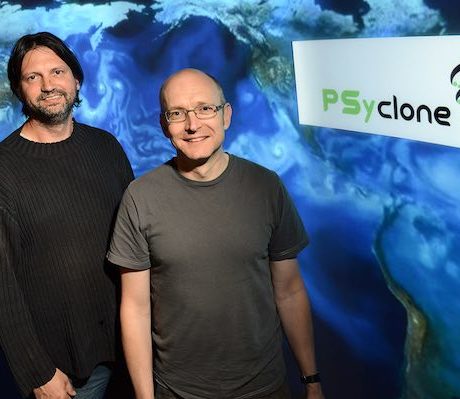
Rupert Ford (left) and Andrew Porter, STFC Scientific Computing
(Credit: STFC)
Developers of atmospheric and oceanographic computer models got a chance last week to hear about a truly innovative and unique piece of software being developed by scientists at the Science and Technology Facilities Council (STFC).
Dr Mike Ashworth from STFC’s Scientific Computing Department showcased PSyclone, a software framework that automatically generates the parts of the code necessary to run on supercomputers. He presented the work of the STFC team that developed it – Rupert Ford, Andrew Porter and Karthee Sivalingam – at the 2016 MultiCore 6 workshop last week September in Boulder, Colorado.
PSyclone was developed for the UK Met Office and is now a part of the build system for Dynamo, the dynamical core currently in development for the Met Office’s ‘next generation’ weather and climate model software.
By generating the complex code needed to make use of thousands of processors, PSyclone leaves the Met Office scientists free to concentrate on the science aspects of the model. This means that they will not have to change their code from something that works on a single processing unit (or core) to something that runs on many thousands of cores.
This is quite a radical approach to the challenge of running models on different kinds of computer architectures,” said Dr Ashworth. “It significantly reduces the potential for errors and will make weather forecasting and climate modeling simpler and more efficient on the high performance computers of the future.”
“It will be of particular interest to those developers who focus on trying to adapt such models for novel and emerging highly parallel computer architectures.”
PSyclone can help a user to parallelise and optimise the code for a particular architecture. Its ability to generate both MPI- and OpenMP-parallel code has enabled the UK Met Office’s prototype dynamical core to go from serial execution to running on more than 50,000 cores with no change to the scientific code base.
Dr Ashworth added, “We are now exploring opportunities to make the PSyclone software framework available for other areas of science and technology, and would welcome discussions with anyone interested in using it.”
Hosted by the US National Center for Atmospheric Research (NCAR), the 2016 MultiCore 6 workshop provides a forum for open discussion to better understand the application of new high performance computing technologies for the next generation of weather, climate, and earth-system models. The new generation of high performance computer architectures present significant challenges to the communities working on these models
PSyclone’s development was funded by the STFC Hartree Centre as part of the GungHo project, a collaboration between STFC, the UK Met Office and the Natural Environment Research Council (NERC).
This story appears here as part of a cross-publishing agreement with Scientific Computing World.




